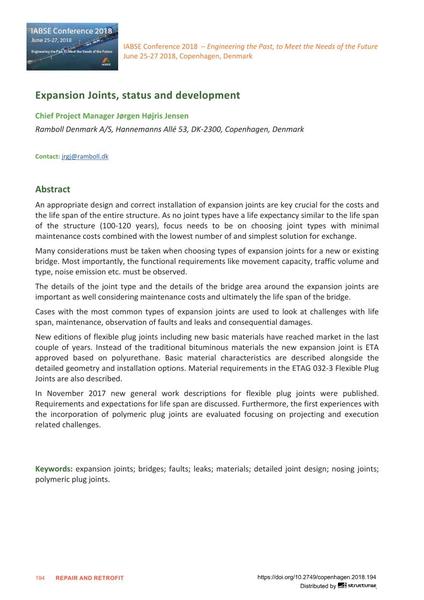Expansion Joints, status and development

|
|
|||||||||||
Détails bibliographiques
| Auteur(s): |
Jørgen Højris Jensen
(Ramboll Denmark A/S, Hannemanns Allé 53, DK-2300, Copenhagen, Denmark)
|
||||
|---|---|---|---|---|---|
| Médium: | papier de conférence | ||||
| Langue(s): | anglais | ||||
| Conférence: | IABSE Conference: Engineering the Past, to Meet the Needs of the Future, Copenhagen, Denmark, 25-27 June 2018 | ||||
| Publié dans: | IABSE Conference Copenhagen 2018 | ||||
|
|||||
| Page(s): | 194-202 | ||||
| Nombre total de pages (du PDF): | 9 | ||||
| DOI: | 10.2749/copenhagen.2018.194 | ||||
| Abstrait: |
An appropriate design and correct installation of expansion joints are key crucial for the costs and the life span of the entire structure. As no joint types have a life expectancy similar to the life span of the structure (100-120 years), focus needs to be on choosing joint types with minimal maintenance costs combined with the lowest number of and simplest solution for exchange. Many considerations must be taken when choosing types of expansion joints for a new or existing bridge. Most importantly, the functional requirements like movement capacity, traffic volume and type, noise emission etc. must be observed. The details of the joint type and the details of the bridge area around the expansion joints are important as well considering maintenance costs and ultimately the life span of the bridge. Cases with the most common types of expansion joints are used to look at challenges with life span, maintenance, observation of faults and leaks and consequential damages. New editions of flexible plug joints including new basic materials have reached market in the last couple of years. Instead of the traditional bituminous materials the new expansion joint is ETA approved based on polyurethane. Basic material characteristics are described alongside the detailed geometry and installation options. Material requirements in the ETAG 032-3 Flexible Plug Joints are also described. In November 2017 new general work descriptions for flexible plug joints were published. Requirements and expectations for life span are discussed. Furthermore, the first experiences with the incorporation of polymeric plug joints are evaluated focusing on projecting and execution related challenges. |
||||
| Mots-clé: |
ponts joints de chaussées
|
||||
